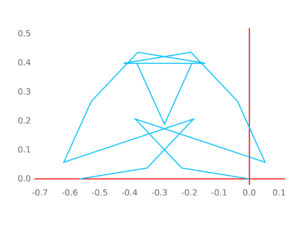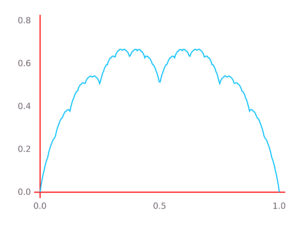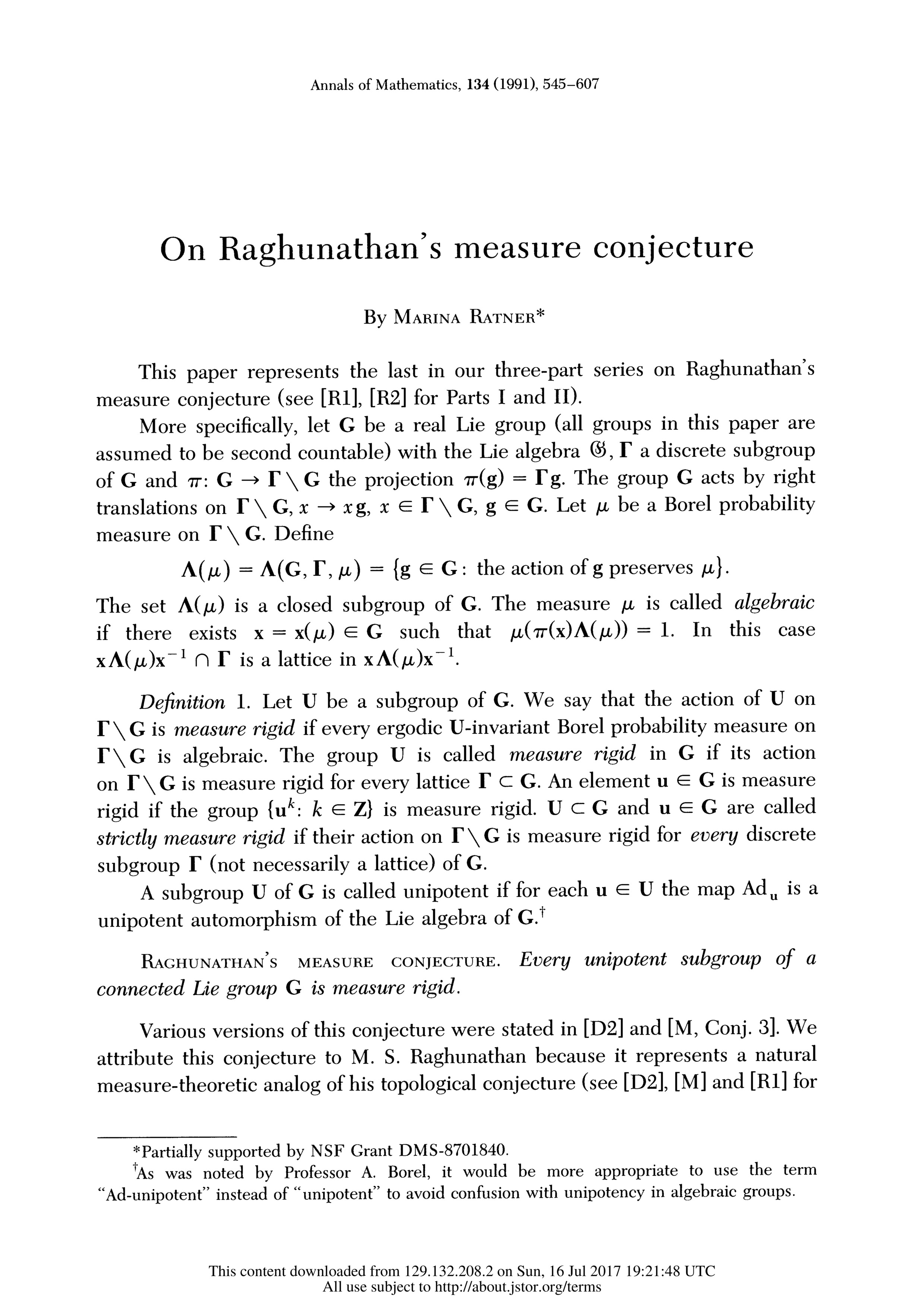Keen-memoried readers will remember the word appearing before on this blog. As one of the happy few who have read “The Unconsoled” twice, I applaud with pleasure the honor given to K. Ishiguro! (If my credentials are disputed, let me clearly state that I can answer the question: “Which spectacular goal scored by a Dutch player during the 1978 World Cup is described in the book?” — or rather, almost, since the description is ambiguous and could apply to two goals by the same player, during different games; I actually remember watching at least one of them).
The Bohr-Pál Theorem and its friends
In the course of writing our paper on the support of the Kloosterman paths, Will Sawin and I encountered some very beautiful classical questions of Fourier analysis. As discussed in the previous post, we were interested in the following question: given a continuous function , such that (1) we have
and (2) the function
has purely imaginary Fourier coefficients
for
, does there exist an increasing homeomorphism
, such that
, and such that the new function
, in addition to the analogue of (1) and (2), also satisfies
for
?
After some searching we found the right keywords, or mathematical attractor, for this type of problem. It starts with a short paper of Gyula, alias Julius, alias Jules, Pál, alias Pal, alias Perl, in 1914, who attributes to Fejér the following question : can one reparameterize a continuous periodic function in such a way that the new function has uniformly convergent Fourier series? Pál shows that he can almost do it: his reparameterized function has Fourier series that converges uniformly on , where
can be arbitrarily small (but the change of variable depends on
).
This Theorem of Pál becomes the Bohr–Pál Theorem after Harald Bohr’s full answer to Fejér’s question in Acta Universitatis Szegediensis in 1935. (Note: I had never looked before at the archive of this particular journal; like most mathematical journals of this period, it is amazing how many names, and even theorems, one can recognize in almost any issue !)
Then comes a beautiful very short proof by Salem in 1944 (it is also the proof found in Zygmund’s book on trigonometric series). All three proofs rely on two results to achieve uniform convergence: one is Riemann’s mapping theorem, and the second is a result of Fejér, according to which the conformal map from the unit disc to the “interior” of a simple closed curve has the property that the boundary Fourier series converges uniformly. In fact, one can certainly write beautiful exercises or exams based on Salem’s proof, for a course in complex analysis that goes as far as Riemann’s Theorem…
The story does not stop here. It is amusing to note that none of Pál, Bohr or Salem feel that it is necessary to point out that they work with real-valued periodic functions. But this is essential to the basic structure of their argument (which starts by viewing as the imaginary part of a complex number that describes a simple closed curve in
, the trick being to define the real part in a suitable way). Whether the Bohr-Pál Theorem holds for complex-valued functions
was an open problem until the late 1970’s (see for instance p. 128 of this 1974 survey of Zalcman about real and complex problems in analysis), when it was proved by Kahane and Katznelson with a completely different approach. They in fact succeeded in proving that one can find a single change of variable
that transforms simultaneously all functions in a compact set of the space of (real-valued periodic) continuous functions into functions with uniformly convergent Fourier series; applied to the real and imaginary parts of a complex-valued function, this gives the required extension.
Coming back to our original question, the complex-variable proofs give some information on the Fourier coefficients of the reparameterized function , precisely they imply that
which is encouraging, even if no pointwise estimate follows. But some variants of the question have been studied that get much closer to what we want. They are discussed (among other things) in a nice survey by Olevskii. I find especially fascinating one theorem of Olevskii himself, published in 1981: it is not always possible to find a change of variable (of a real-valued periodic continuous function) so that the reparameterized function has an absolutely convergent Fourier series. This answers a question of Luzin, and is explained in Section 3 of Olevskii’s survey. Interestingly, this problem is now, of course, easier for complex-valued functions, compared to real-valued functions, and it was also solved by Kahane and Katznelson in the -valued case.
The result that turned out to be most useful for our purposes is
due to Sahakyan (whose name is also spelled Saakjan or Saakyan). He proves the existence of reparameterizations of a continuous periodic function
satisfying various asymptotic bounds for their Fourier coefficients. The result is here also restricted to real-valued functions, and again for a clear reason: the construction relies crucially on the intermediate value theorem for continuous functions. More precisely, Sahakyan’s idea is to use the Faber-Schauder expansions of continuous functions, and to find a change of variable that leads to a function
with a “sparse” Faber-Schauder expansion, from which he estimates directly the Fourier coefficients using bounds for those of the Faber-Schauder functions. (I actually didn’t know about Faber-Schauder expansions before; I will also certainly make use of them for analysis or functional analysis exercises later…) This works because the Faber-Schauder coefficients are quite simple: they are of the form
for suitable real numbers . One can now easily imagine how the intermediate value theorem will make it possible to find a change of variable to make such a coefficient vanish.
Using Sahakyan’s main lemma, with a few modifications to take into account the additional symmetry we require, we were able to solve our reparameterization problem for the support of Kloosterman paths, in the case of real-valued functions. The complex-value case, as far as we know, remains open…
The support of Kloosterman paths
Will Sawin and I just put up on arXiv a preprint that is the natural follow-up to our paper on those most alluring of shapes, the Kloosterman paths.
As the title indicates, we are looking this time at the support of the limiting random Fourier series that arose in that first paper, namely
where is a sequence of independent Sato-Tate-distributed random variables. In a strict sense, this should be a very short paper, since the computation of the support is easily achieved using some basic probability and elementary properties of Fourier series: it is the set of continuous functions
such that (1) the value of
at
is real and belongs to
; (2) the function
has purely imaginary Fourier coefficients
for
; (3) we have
for all
.
So why is the paper 26 pages long? The reason is that this support (call it ) is a rather interesting set of functions, and we spend the rest of the paper exploring some of its properties. Most importantly, the support is not all functions, so we can play the game of picking our favorite continuous function on
(say
) and ask whether or not
belongs to
.
For instance:
- Fixing a prime
, and
,
invertible modulo
, does the Kloosterman path
itself belong to the support? Simple computations show that it depends on
! For instance, the path for the Kloosterman sum
, shown below, does not belong to the support. (As we observe, it looks like a Shadok, whose mathematical abilities are well-known — sorry, the last link is only in French ; I suggest to every French-aware reader to watch the corresponding episode, since the voice of C. Piéplu achieves the seemingly impossible in making this hilarious text even funnier…)

Kl_2(8,1;19) - On the other hand, the path giving the graph of the Takagi function
(namely
) belongs to the support.

Takagi function -
But maybe the most interesting problem from a mathematical point of view is one of pure analysis: when we see a Kloosterman path (such as the one above), we only see its image as a function from
to
, independently of the parameterization of the path. So we can take any shape in the plane that can be represented as the image of a function
satisfying the conditions (1) and (2) above, and ask: is there a reparameterization of
that belongs to the suppport? For instance, for the Kloosterman paths themselves (as in (1) above), it is not difficult to find one: instead of following each of the
segments making the Kloosterman path in time
, one can insert a “pause” of length
at the beginning and end of the path, and then divide equally the remaining time for the
segments. (The fact that this re-parameterized path, whose image is still the same Kloosterman path, belongs to the support
is then an elementary consequence of the Weil bound for Kloosterman sums).
-
In general, the question is whether a given
has a reparameterization with Fourier coefficients (rather, those of
) are all smaller than
. This is an intriguing problem, and looking into it brought us into contact with some very nice classical questions in Fourier analysis, that I discuss in this later post. We only succeeded in proving the existence of a suitable reparameterization for real-valued functions, for reasons explained in the aforementioned later post, and it is an interesting analysis problem whether the result holds for all functions. A positive answer would in particular settle another natural question that we haven’t been able to handle yet: is there a space-filling curve in the support of the Kloosterman paths?
All this is great analytic fun. But there are nice arithmetic consequences of our result. By the definition of the support, we know at least that any has the property that, with positive probability, the actual path of the partial sums of the Kloosterman sums will come as close as we want (uniformly on
) to
, and this is an arithmetic statement. For instance, simply because the zero function belongs to the support, we deduce that, for a large prime
, there is a positive proportion of
such that all partial sums
for , have modulus
.
In other words, there is a non-zero probability that all the normalized partial sums of the Kloosterman sums are very small. (It is interesting to note that this is emphetically not true for character sums… the point is that their Fourier expansion involves multiplicative coefficients, so they cannot become smaller than .)
Tornare a Ventotene
I participated last week to the wonderful Ventotene 2017 Conference, a worthy continuation of Ventotene 2015. Reaching the island required this time even more of the stamina that the conference website recommends, since the weather was rough enough that the faster hydrofoil boat did not run (stranding about 30 of the participants in Formia on Sunday evening), while even the rather bigger one behaved more like a large scale roller-coaster than most people would wish.
After arriving at the island, Monday was still a bit unpleasant (it was much more for those who were unlucky to be exposed when one of the few short but very violent rain showers fell…), but the remaining of the time was beautiful. On the way back, I had to stop in Rome for a night, and tasted the most delicious ragù bianco di coniglio that one can imagine.





I’m already looking forward to the next conference…

